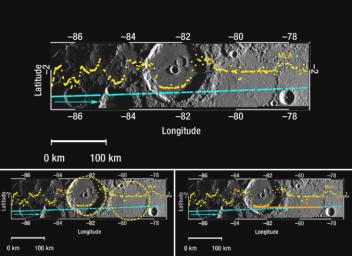
|
Mercury Laser Altimeter (MLA) Measures the Depths of Mercury’s Craters
- Click the image above for a larger view
- Full-Res JPEG (719 x 523) (65.5 kB)
- Full-Res TIFF (719 x 523) (1.1 MB)
Caption:
This figure shows a 400-kilometer-long (250-mile-long) section of the MLA profile from MESSENGER's second Mercury flyby superposed on a high-resolution NAC departure mosaic acquired during the same encounter. The blue dots indicate the spacecraft ground track, and the yellow dots show the altimetry data points; the blue arrow shows the spacecraft's direction of travel. Near the center of this profile, the MLA track crosses two craters of comparable sizes but different depths (outlined by yellow circles in the lower left figure). The deeper crater in the center of the track is Machaut crater (see PIA11249 ), while the unnamed crater to Machaut's east is considerably shallower. The lower right figure compares the depths of the two craters, indicating the difference measured by MLA with orange arrows. From the NAC mosaic it is apparent that the shallower crater has been filled, probably by volcanic material. By making such measurements systematically over the surface, it will be possible to measure the volumes of volcanic material erupted over Mercury's history.
Date Acquired:
October 6, 2008
Instrument:
Mercury Laser Altimeter (MLA), Narrow Angle Camera (NAC)
Scale:
Machaut crater is 106 kilometers (66 miles) in diameter
Background Info:
These images are from MESSENGER, a NASA Discovery mission to conduct the first orbital study of the innermost planet, Mercury. For information regarding the use of images, see the MESSENGER image use policy .
Cataloging Keywords:
| Name | Value | Additional Values |
|---|---|---|
| Target | Mercury | |
| System | ||
| Target Type | Planet | |
| Mission | MESSENGER | |
| Instrument Host | MESSENGER | |
| Host Type | Orbiter | |
| Instrument | Mercury Dual Imaging System (MDIS) | Mercury Laser Altimeter (MLA) |
| Detector | Narrow Angle Camera (NAC) | |
| Extra Keywords | Color, Crater, Volcano | |
| Acquisition Date | ||
| Release Date | 2008-10-31 | |
| Date in Caption | 2008-10-06 | |
| Image Credit | NASA/Johns Hopkins University Applied Physics Laboratory/Carnegie Institution of Washington | |
| Source | photojournal.jpl.nasa.gov/catalog/PIA11414 | |
| Identifier | PIA11414 | |
